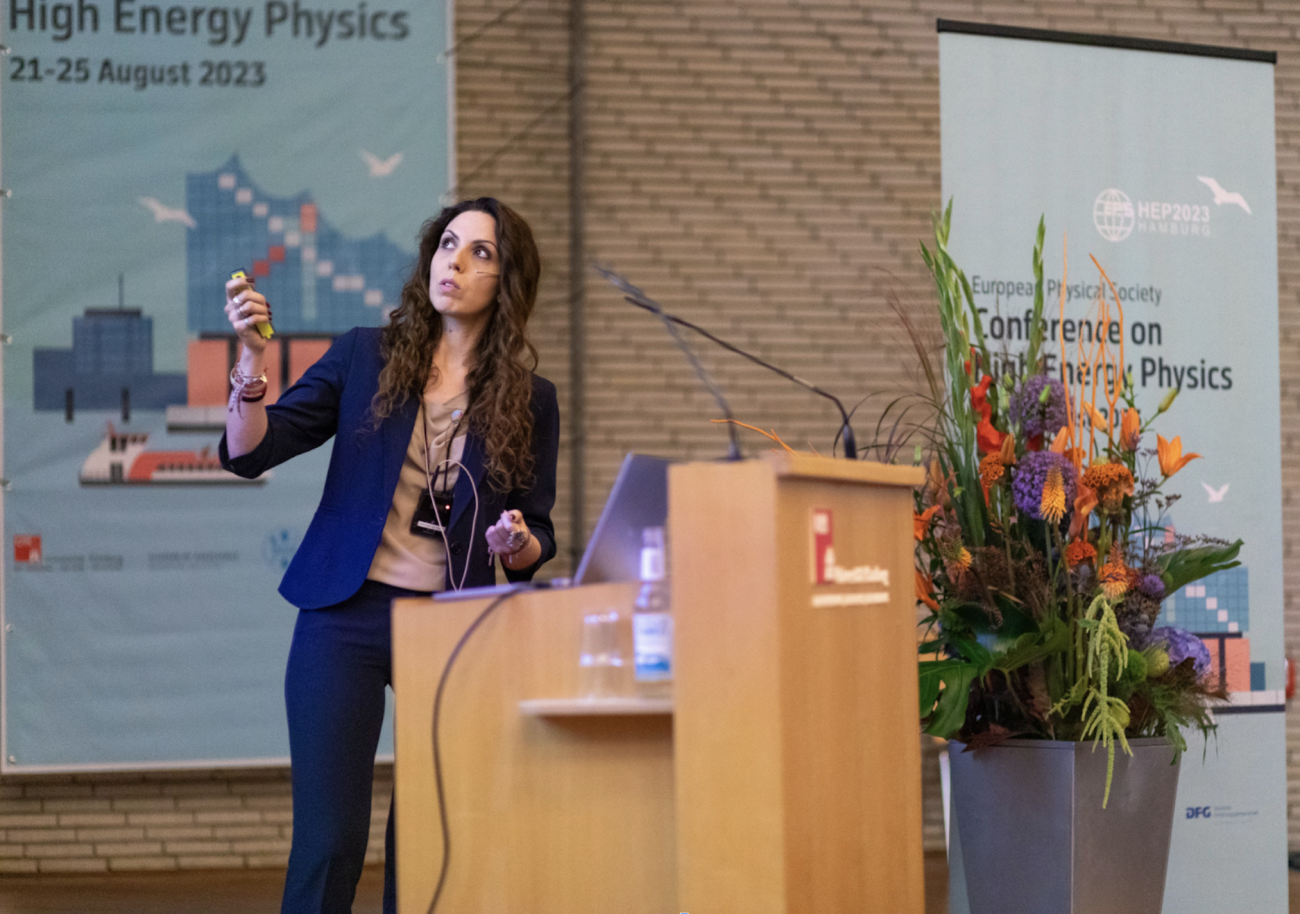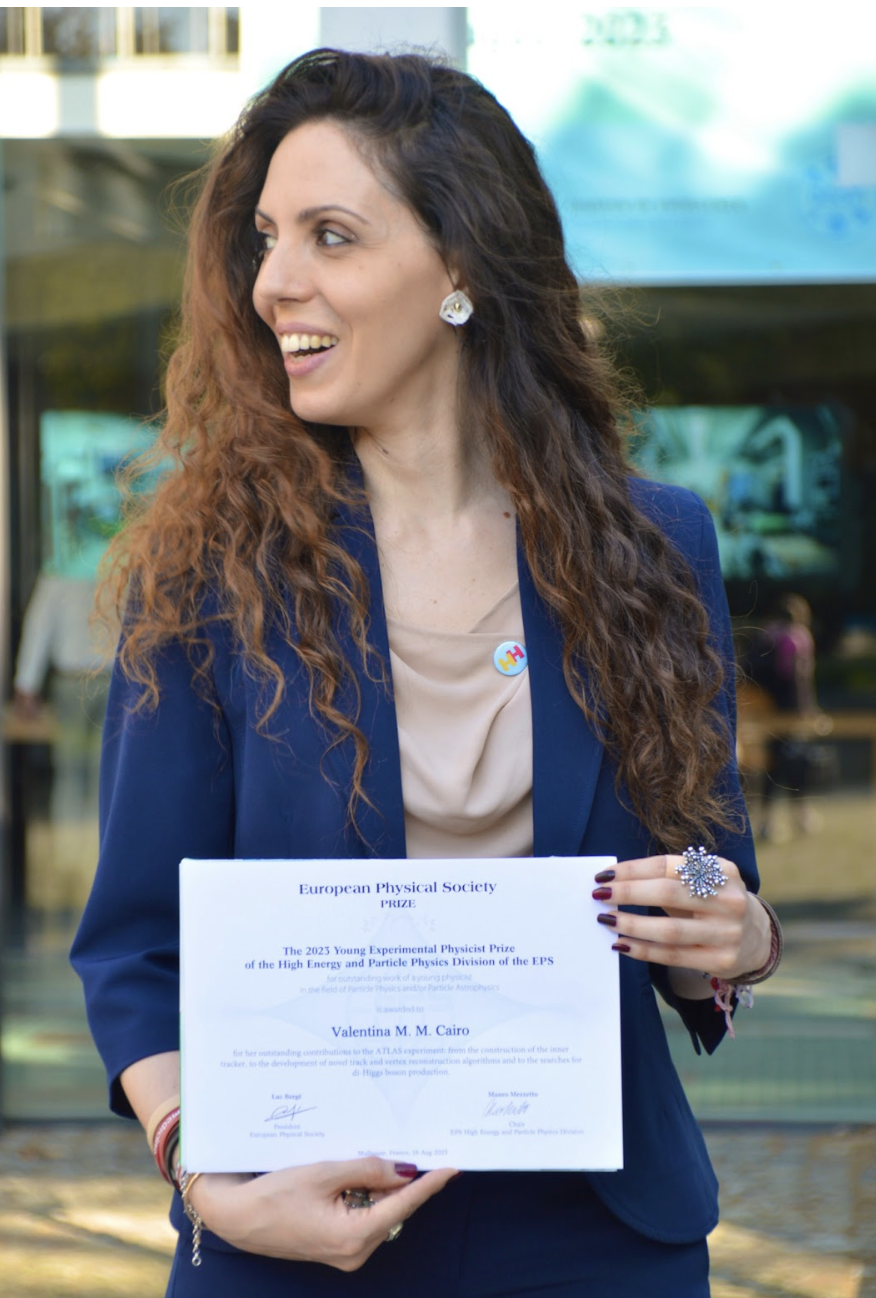In discussion with Valentina Cairo

Earlier this summer, the 2023 Young Experimental Physicist Prize of the High Energy and Particle Physics Division of the European Physical Society – for early career experimental physicists – was awarded to CERN staff physicist Valentina Cairo for her outstanding contributions to the ATLAS experiment: from the construction of the inner tracker, to the development of novel track and vertex reconstruction algorithms and to searches for di-Higgs boson production.
Valentina Cairo arrived at CERN in 2013 as a summer student to work on the development of micropattern gaseous detectors within CERN’s Technology Department. Coming to CERN as a summer student was a life-changing experience that inspired her future work on detector technologies and tracking algorithms. “I grew up in a small lovely place called Bisignano, near Cosenza in Italy, and studied at the nearby Università della Calabria. When I applied for CERN’s summer student programme, I had low expectations, given the very competitive nature of the programme. Yet, the acceptance letter arrived and to my surprise I earned a position to go to CERN”. Therefore, Valentina’s message to future students is: “Never give up and always remain curious! For young students with an interest in physics, a summer at CERN can be a game changer, and they should definitely seize the opportunity and apply”.
Valentina returned to CERN as a Doctoral Student, and the seed planted during her undergraduate studies gave fruits at the time of deciding the topic of her PhD thesis. Valentina worked on track reconstruction for the ATLAS experiment in preparation for the imminent start of Run 2, optimising the algorithms for the very first soft QCD analyses. “Pursuing a PhD at the start of Run 2 was exciting and hectic at the same time. At that point, ATLAS saw a major upgrade of its tracker, thus requiring from us to rewrite many of the event reconstruction algorithms and ensure that they would work, and they would be optimal during the new run. This allowed us to measure how many charged particles were produced in each proton-proton collision. This information is key to fully understanding the complexity of the LHC events”.
During her time as a postdoctoral researcher at SLAC, Valentina's interests also evolved from tracking algorithms to the construction of the ATLAS Inner Tracker for High-Luminosity LHC and from Standard Model analyses to the measurement of the Higgs boson self-coupling. The latter is currently the focus of her activities.
The non-trivial structure of the Higgs potential is responsible for the Higgs mechanism, which gives mass to other Standard-Model particles, and is key to understanding the stability of our Universe. Measuring the strength of Higgs boson interaction with itself – the “Higgs boson self-coupling”, which is one of the main Higgs properties that is still largely unconstrained – could give direct insight into the structure of the Higgs potential. Valentina adds: “Searching for the production of Higgs boson pairs is compelling in this context, as they give us direct access to the Higgs self coupling. According to the Standard Model, the Higgs potential has the shape of a Mexican hat, but we won’t know that until we measure it experimentally”. Results can also shed light on the existence of phenomena beyond the Standard Model if the self-coupling deviates significantly from the Standard-Model prediction.
Higgs boson pairs are rarely produced at the LHC. Valentina explains: “LHC gives us a Higgs boson per one billion collisions, while we could get a Higgs pair in one out of a trillion collisions. Therefore, we look for several signatures of the Higgs boson decays”. In fact, when searching for di-Higgs events, physicists typically focus on one Higgs boson in its most abundant decay into two bottom quarks (bb), and the other Higgs boson decaying to different particles, for example another pair of bottom quarks (bbbb), two tau leptons (bbττ), two photons (bbγγ), or combinations of vector bosons. Each final state presents different strengths and challenges. Valentina led the full Run 2 bbyy analysis that set world-leading constraints on the Higgs self-coupling. Furthermore, she is currently co-leading the full ATLAS di-Higgs group consisting of more than 300 collaborators around the world.

An illustration made by Federica Cairo used for the cover page of the EPS talk. “Tracking down the Higgs boson Properties in ATLAS” (Read more).
With the Run 2 dataset, physicists set new upper exclusion limits on the di-Higgs signal strength – that is, the observed event rate over the Standard-Model prediction – from bbbb, bbττ, bbγγ and their combination. The combined limit at 95% confidence level is set at about 3 times the Standard-Model prediction. This is a forceful constraint on the di-Higgs production rate. “With the analysed data, we have reached a sensitivity of about 3 times the Standard Model. This means that to “see” a di-Higgs signal in the Run 2 dataset, it would have to be about 3 times as large as what the Standard model predicts. More statistics will take us closer to probing the Standard Model predictions”. This is what motivates the excitement about the new data that will be collected during Run 3 as they would mean more statistics to get closer to the first glimpse of di-Higgs evidence. Furthermore, this search will largely benefit from the high-luminosity phase of the LHC towards observation of di-Higgs production, giving more accuracy in the measurement of the Higgs self-coupling.
Direct searches are not the only way to study the Higgs boson’s interaction with itself. The self-interaction is also expected to impact processes in which only a single Higgs boson is produced. “With next-to-leading order corrections to the single Higgs production process, we also have access to loops where the Higgs-self coupling plays a role”. As Valentina says: “With “indirect” searches via single Higgs production, we are less sensitive to the Higgs self-coupling, but we have more statistics compared to di-Higgs. These two processes are complementary, and what we typically do is to combine the information from the two channels to constrain simultaneously various Higgs couplings.”
For Run 3, Valentina explains that some major improvements expected for di-Higgs analyses, along with changes to the trigger strategies, will come from updates in the event reconstruction techniques. The multitude of final states explored in di-Higgs searches requires efficient and precise algorithms for the identification of physics objects. Charged-particle tracks and interaction vertices are two key building blocks for the reconstruction of any other object in particle physics. Valentina has been working on tracking and vertexing since she was a student. Originally, she worked to develop and optimise tracking algorithms for low-momentum particles and to measure the passive material in the ATLAS tracker. Lately, she coordinated the ATLAS tracking group at the beginning of Run 3. This was one of the most challenging moments in her career due to the intense preparations, but also one of the most rewarding thanks to the interactions with a diverse group of colleagues bringing their expertise in this effort. “During the shutdown, ATLAS has developed several very performant algorithms for object reconstruction. We will benefit a lot from this and will continue to improve upon them while also introducing new analysis techniques”. Presently, she is working to develop algorithms that could embed 4-dimensional tracking into jet flavour tagging and understand how much information could be gained for di-Higgs analyses; a technique that could potentially find applications in HL-LHC and future colliders.

Valentina Cairo, holding the certificate of the 2023 Young Experimental Physicist Prize for her outstanding contributions to the ATLAS experiment. Credits: Federica Cairo
Speaking about the future, Valentina thinks that there are several missing pieces in the Higgs puzzle that are yet to be found. The Higgs self-coupling is one of them, but we also don’t know how the Higgs boson couples to the lightest quarks. “With innovative detectors and algorithms at future Higgs factories we could, for example, search for Higgs bosons decaying into strange quarks to shed light on the mystery of flavour in the Higgs sector.”
The recent EPS award offers a motivation but also a confirmation of the value of this research, connecting event reconstruction, analysis techniques and detector development, for the wider physics community. As Valentina notes: “This is a journey that I couldn’t have done alone. In this path, I had the pleasure of collaborating with brilliant and creative colleagues within the ATLAS collaboration, without whom these achievements would not have been possible.”
